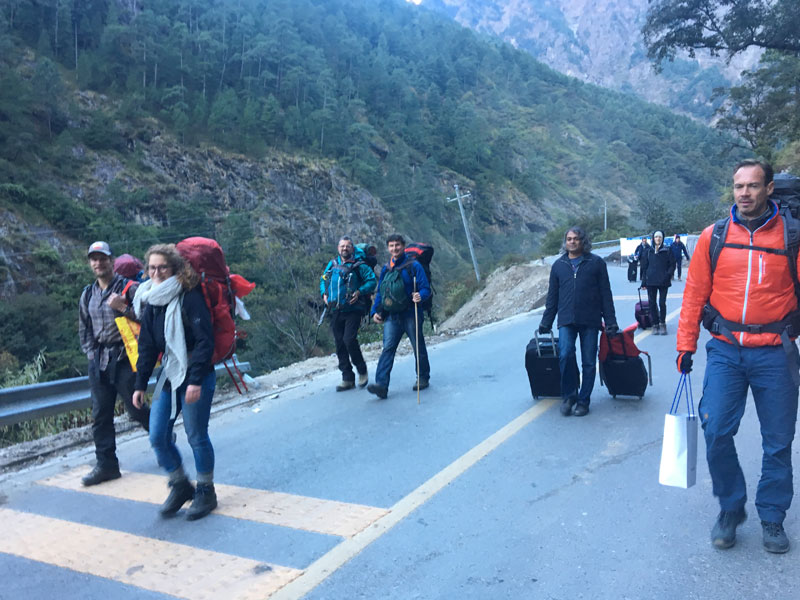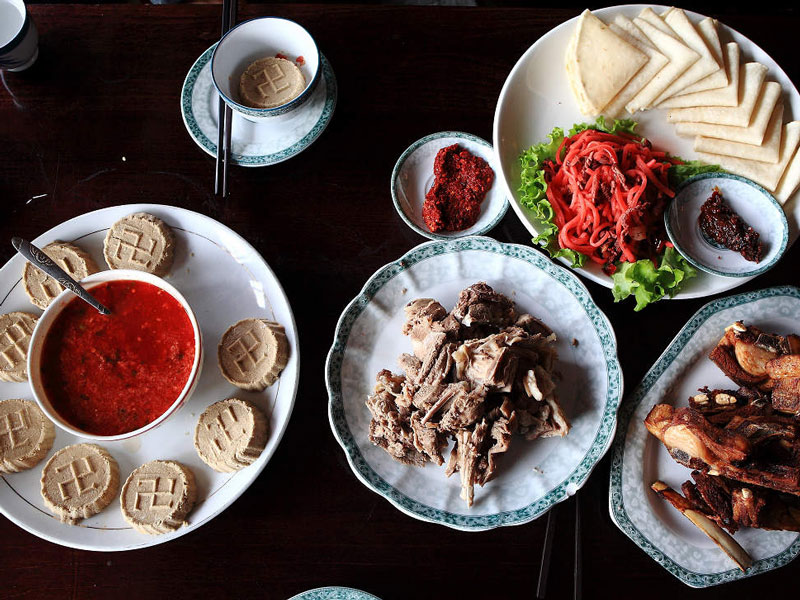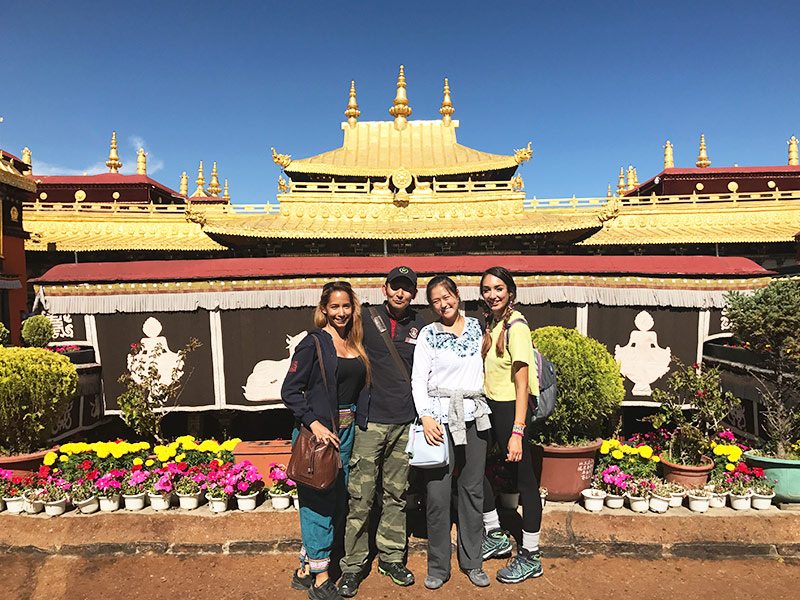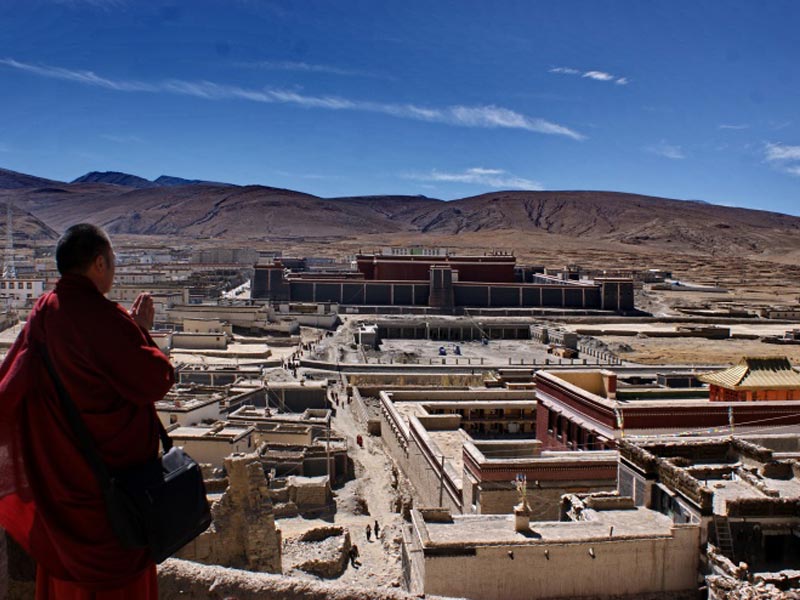Gyirong Port, the newest border crossing from Nepal into Tibet in China, is one of the most important modern border crossings in the world, and is set to become even more important as time passes and railways link the plateau with the exotic city of Kathmandu. While the port was originally used from the 8th century as an exchange point between the Tibetan Empire and the kings of Nepal, it was not really widely used as a true land port until 1972. Since 2014, the port has been the largest border crossing between Nepal and China, and since the earthquake of 2015, it has been the only tourist border crossing open to Tibet.
Gyirong Port Location: where is Gyirong Port?
Lying in the far west of Tibet, right on the border with Nepal, Gyirong Port is the small collection of buildings that house the immigration and customs departments for entry to China from Nepal. The border crossing lies 64.17 kilometers (39.88 miles) due north of the Nepali capital of Kathmandu, and around 580 kilometers (360 miles) from Lhasa, in a direct line. By road, Gyirong Port is a distance of 835 kilometers (519 miles) from Lhasa, the Tibetan capital, and around 568 kilometers (353 miles) from Shigatse, Tibet’s second city.
Sitting right on the border due north of the Nepali capital of Kathmandu, Gyirong Port sits on the northern ridge of the Trishuli River Gorge, over which the Resuo Bridge spans, the crossing point between Nepal and Tibet. The port is actually only 24 kilometers from the town of Gyirong, in Gyirong County of Shigatse Prefecture.
What to See in Gyirong
While there is little to actually see at Gyirong Port, Gyirong County is rated as having one of the most beautiful valleys in the world, the relatively unknown Gyirong Valley. While much of the area around Gyirong is not explored much by international tourists on tours of Tibet, this amazing little county has some of the most stunning attractions in western Tibet.
As the deepest of the five mid-Himalayas Valleys, Gyirong Valley is one of the most stunning locations in Tibet for lush flora and abundant fauna, and has been rated as the most beautiful unknown valley on the plateau.
The Gongtang Kingdom flourished in the area of Gyirong in the 11th century, and remained for more than 600 years, falling into ruins with the rise of the Dalai Lama’s power over central and western Tibet in the 17th century. Now, all that is left are ruins, though they are renowned as some of the most impressive “ruins” in the world, with the Dolma Lhakhang still standing and four sections of the royal palace still fending off the ravages of time.
Nitsun is a small local village in the Gyirong Valley, and is considered to be a ‘holy place that has been blessed by the deities’, according to the local people. Set in some of the most beautiful pasturelands in the world, this outstanding little community is the epitome of traditional Tibetan living, and the friendly people will welcome you warmly.
Best Time to Visit Gyirong Port
Known as the “backyard of the Himalayas”, Gyirong has a lower elevation than the rest of the area around the border, and thus has a much milder climate. This milder climate means more lush vegetation and the ability to travel to the area at any time of the year, even in the depths of winter. The bridge into Tibet from Nepal crosses the border at an altitude of just 1,860 meters, and the small town of Gyirong, just to the north of the border, is just 2,800 meters above sea level.
The Gyirong area is split into two separate climate areas, with the northern end of the county experiencing a semi-arid monsoon climate, while the southern half has a more sub-tropical climate. In the north, summer temperatures can range up to 18 degrees, with nights dropping to only around 10 degrees. However, winters, while not seeing much snow, can see temperatures drop to as low as -10 degrees at night.
In the south, the warmer subtropical climate results in higher summer temperatures and milder, damp winters, with higher humidity throughout the entire year. Winters in the south are short and often a little wet, with little frost or snow.
Overall, the best time to travel around Gyirong would be in the warmer months from May to October, with the best months coming from June to September. However, there is really no bar to traveling in the area throughout the year, and the abundance of natural beauty is enough to temp travelers at any time.
How to Get to Gyirong Port from Tibet
Travel from Lhasa to Gyirong Port (835.8 kilometers )
Getting to Gyirong Port from Lhasa is normally done as part of a Tibet tour to Kathmandu in Nepal. If you were to travel directly to Gyirong Port from Lhasa, the journey would take around 12 hours of constant driving and cover a distance of 835.8 kilometers (519.34 miles). The route from Lhasa follows the Friendship Highway, along the G318 National highway, out of the capital to Shigatse, and then on to Tingri. A little after leaving Tingri, the route switches to the S214 Provincial Highway, which loops up around Gyirong County and passes to the south of Lake Peiku Tso to Gyirong Town, and then south to the border.
>> 7 Days Lhasa to Kathmandu Overland Small Group Tour
Travel from Mount Everest to Gyirong Port (355 kilometers)
Getting to Gyirong Port from Mount Everest is almost the same as the latter part of the route from Lhasa, as the road that stretches south to the base camp of the world’s highest mountain departs from the Friendship Highway at Old Tingri. From Mount Everest, the road heads north from the Rongbuk Monastery, and follows the Zhufeng Road all the way along its winding course to the Friendship Highway in Tingri County. From the actual base camp itself, the distance to Gyirong along the main route is around 355 kilometers (220 miles). With constant driving, this would take around seven hours to complete.
>> 15 Days Beijing Lhasa Kathmandu Overland Tour
Travel from Mount Kailash to Gyirong Port (690 kilometers)
The drive from Mount Kailash in the northwest of Ngari Prefecture is a long one, covering around 690 kilometers (429 miles). After leaving Darchen, at the foot of Mount Kailash, the road takes you through Hor Qu on the northeast corner of Lake Manasarovar, and then heads southeast along the G219, passing through Payang and Zhongba, before finally reaching the town of Saga.
From Saga, the route departs from the G219, and heads south on the Lunzhu Road out of the town, through Zheba, turning onto the S214 at Jia Ji Xian, in Gyirong County. From here, the route runs south along the valleys all the way to Gyirong town, and then onto the border crossing at Gyirong Port.
>> 13 Day Lhasa, Mt. Everest, Mt. Kailash, Lake Manasarovar and Kathmandu Adventure Tour
Visa & Permit for entering Nepal from Tibet via Gyirong Port
For those traveling to Nepal from Tibet, the Frontier Pass, which is required for all travelers, domestic and international, covers travel to any of the border regions of China in Tibet, including the borders with Nepal, India, and Bhutan. This is obtained by your tour guide in Lhasa, and takes just a few hours to process, before you leave the capital.
You will also need to obtain a visa to enter Nepal from China. The visa takes up to an hour to process once you arrive in Nepal, and requires only your valid passport, a photo, and the completed application form with the fee of around 30 dollars.
How to Get to Gyirong Port from Nepal
Travel from Kathmandu to Gyirong Port (149km-155km)
The route from Kathmandu to Gyirong Port is one that covers a distance of between 149km and 155km, depending on the route. Buses tend to take the longer route, which takes around seven hours of travel, including meal stop along the way. The roads both depart Kathmandu, one heading west while the other heads northwest. However, both join the Pasang-Lhamu Highway, which runs north through the Langtang National Park to Rasuwa Gadhi and finally across the Resuo Bridge to Gyirong Port.
>> 8 Days Kathmandu to Lhasa Driving Across Himalaya Overland Adventure Tour
Visa & Permit for entering Tibet from Nepal via Gyirong Port
There are a number of permits you will need to enter Tibet from Nepal. These include:
Tibet Travel Permit – This is required for entry to Tibet and to travel around in the area of Lhasa.
Alien’s Travel Permit – Required for travel to the “unopened” areas of Tibet outside Lhasa, including Shigatse.
Frontier Pass – While most tours will not actually cross the border out of China, the Frontier Pass is required for all tourists traveling in the areas of the Chinese border with India, Nepal, and Bhutan, which includes Mount Everest and Mount Kailash.
Chinese Group Visa – You will also need the Chinese Group Visa, instead of the normal Chinese Entry Visa that would be used to enter China from anywhere else. The group visa is only available once you arrive in Kathmandu, and can only be obtained by us once your documents and permits are all complete. We will make the application on your behalf, which takes around three working days.
Accommodation and Dining at Gyirong Town
Accommodation in Gyirong Town is a lot better than it was just two years ago, and there are a few better hotels and guesthouses that have popped up since the crossing became more well-established. The main hotels in town now include the Gyirong Shengtai Hotel, the Shigatse Gyirong Shengyuan Hotel, the Shigatse Silver Star Hotel, and the Mount Everest Backyard Garden Business Hotel, all of which are rated as 3-star in Tibet. The Gyirong Hand & Hand International Hostel is the only budget hostel in Gyirong, and only had 13 beds, so it may not be available.
There are not many places to eat outside the normal hotels and guesthouses in Gyirong Town, as this small community is only recently coming into its own as a place to stop for tourists. However, there are a few places that are worth trying, and these mostly sell either Tibetan or Chinese cuisine, or a mix of both. Small restaurants such as the Dayi Restaurant, the Beef Stretched Noodle Restaurant, the Chongzhou Restaurant, the Lanzhou Bannock, and the Kang Sur Tibetan restaurant all cater to both locals and foreigners. You are unlikely to find much in the way of western food here though.
Conclusion
Gyirong Port was once just a small border crossing for nomadic herders, Nepali traders, and local villagers for more than 1,300 years. Now, it is the largest overland port in China, and handles thousands of travelers and traders every day. The only overland entry from a foreign country into China’s Tibet Autonomous Region, this beautiful part of the Tibetan plateau is set to be one of the most famous, as the train from Lhasa to Kathmandu, the first train to cross the Himalayas, will eventually cross the Sino-Nepal border here.
.jpg)
















0 Comment ON "Ultimate Guide to Gyirong Port, Nepal Tibet Border Crossing"